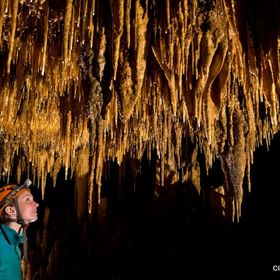

cavercse
FollowMy younger brother, Matthew Elmore, squeezing through a very tight slot in this Tennessee cave.
My younger brother, Matthew Elmore, squeezing through a very tight slot in this Tennessee cave.
Read less
Read less
Views
322
Likes
Top Ranks
Categories
Same photographer See allBehind The Lens
Discover more photos See all
Behind The Lens
Location
This is a photograph of my brother, Matthew Elmore, squeezing through an extremely tight passage in a cave called "Big Boy Canyon Cave" right outside of Sparta, Tennessee. Tennessee's longest cave, the 38-mile-long Blue Spring Cave, lies just across the valley from Big Boy Canyon Cave, though no connection exist between the two. The county that is home to both caves, White County, has the highest documented cave density in the world with over 3.17 caves per square mile. Tennessee is truly one of the greatest places to live on the planet if you are interested in exploring the dark and cold underworld of caves.Time
The photo was likely taken sometime in the afternoon, though the time really has no impact in cave photography due to the lack of any natural light.Lighting
Cave photography is a very unique type of photography with regards to lighting. There is no natural light, so you have to provide every bit of the light for the photo. It's very unique to shoot photos in a location where the shutter of the camera can be held open for just a few seconds or a few weeks and it wouldn't make bit a difference. I find that the easiest way to do lighting in cave photography is to carry in cheap used flashes with radio triggers. Thought this brings up another aspect of cave photography: caves destroy gear in such a relatively short time that everything has to be cheap or bombproof.Equipment
This photo was taken using an Olympus Pen E-PL1 with a 12mm f2.0 Panasonic lens. This setup makes a really good setup for cave photography due to the small size, cheap price, fast lens, and the lack of external moving parts on the lens (cave sand rapidly destroys lenses that externally move when focusing). For lighting, I had one old Sunpak 433d covered by a piece of wax paper held in place by a rubber band (to help subdue the typically harsh light output of the old Sunpak flashes) that was triggered via a Yongnuo RF-603 wireless flash trigger. The greatest aspect of this setup is that I don't have to carry a tripod with me and that makes a huge difference when traveling through a cave.Inspiration
I took my camera on the cave trip in anticipation of seeing some nice cave passage or cave formations to shoot pictures of. When we reached the cave, I started to navigate through the labyrinth of passage with the official cave description in hand. I quickly realized that the cave was far too complex to locate the areas I wanted to reach without a cave map (currently no map for Big Boy Canyon Cave has been produced). After that revelation, me, Matthew, and our two friends started shooting photos near the beginning of the cave. We reached the extremely tight passage shown in the photo and while Matthew was trying to squeeze through, I found an alternative way around. I quickly pulled out my camera gear and snapped a few photos and this was one of them.Editing
Yes, most cave photographs ether require post processing or many different flashes to add depth. Shooting one flash from the direction of the camera towards the subject will almost always flatten the photo. With this photo, I held the flash as far above the camera as I could to increase the offset between the direction the camera is looking and the direction the flash is facing. Increasing that offset between the camera and the flash is hugely important in low light photography as it brings out all the subtle shadows that create this feeling of depth. To a point, this worked well in this photograph; however, due to the snug size of the passage and me having to hold both camera and flash, I could only do this to a point. This is where post processing comes in to save the day. I shot this photograph as a RAW file and processed it as a very mild HDR blend. This blend what then overlaid on the normally processed photo to keep it from looking like HDR while keeping that extra detail that HDR brings out of a RAW image. It's a long process but it can really make up for a situation where you only have less-than-ideal lighting to work with.In my camera bag
It depends entirely on the cave trip. Some caves are big, nice, dry, and easy to traverse; in these caves I carry a full DSLR with an ultra-wide lens, tripod, flashes, radio triggers, wax paper, and rubber bands. I often carry three electric flashes with me on caves with smaller passage, though we do have massive cave rooms here in Tennessee that require flashbulbs to shoot. With those massive cave rooms, I mostly use M3 bulbs or fp26/p25 bulbs for the smaller of the big rooms and I move up to 2A's of 3's, depending on which ones I have the most of. One important aspect of my gear is the case or cases I carry everything in; as I said before, caves will kill off gear very quickly. I usually carry my camera in a 1200 size pelican case and carry everything else in what us cave explorers call "Darren Drums", which were originally used for food storage until British Cavers started using them in freezing-cold wet caves that the UK is known for. Eventually US cavers started using Darren Drums as well, now we can't live without them.Feedback
It takes a lot of practice to get good at working with such unique conditions, but don't give up and don't be afraid to try unorthodox techniques; cave photography and caving in general is all about unorthodox solutions and thinking outside of the box. Don't be afraid to use post processing. There are many nature photographers and even cave photographers who consider most post processing "unnatural". The thing is, almost all cave photography requires unnatural lighting when you really get down to it. A truly natural cave photo would be completely black, showcasing the extreme darkness of the environment. Another big thing is to not worry about having top-of-the-line gear. Cheap cameras with manual controls can be used to great effect with enough lighting, a subject who can sit very still, and a cheap tripod. I personally used a cheap Canon point-and-shoot with manual controls for years before investing in a better, but still cheap, camera setup. In general, cave photography is very hard, often under appreciated, heavily dependent on helpers, and done in extremely inhospitable environments. Also, take extreme care when visiting caves. In addition to being dangerous, caves are a unique in the aspect that they are often nearly untouched by man, and cavers work very hard to keep it that way. Almost every feature in a cave is extremely fragile and the only way our grandkids can enjoy the amazing beauty of this underground world is if we leave as little impact as possible. Don't let this deter you either, cave photographers and cavers are both hugely important when it comes to bringing important cave features to the attention of scientist. Without the documentation provided by the large community of cave explorers in Tennessee, we could never effectively study, explore, photograph, and work to protect the vast number of caves we have. I you do decide to venture underground, make sure to learn the safest modern caving techniques and leave as little impact as possible. You can contact the National Speleological Society, or NSS, to learn about your local caving clubs and organizations if do you want to become a caver. They will often take you in and teach you everything you need to know about caves in your local area.












































